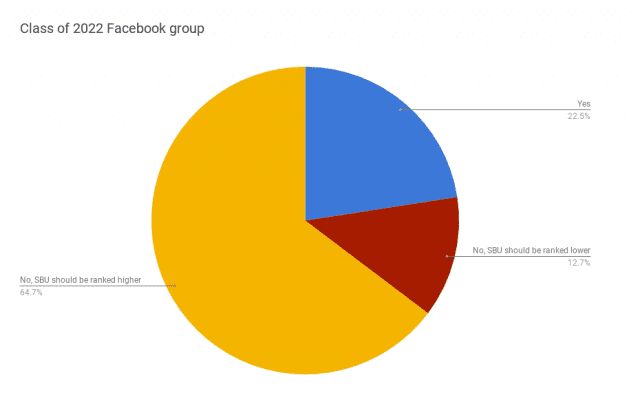
This year’s U.S. News & World Report 2019 national university rankings listed Stony Brook University as the 80th-best college in the country, tied with Binghamton University, the Colorado School of Mines, North Carolina State University-Raleigh, Texas Christian University and Yeshiva University.
…Really? Are you sure?
U.S. News’ annual rankings are based on 16 criteria, including freshman retention, graduation rates and the strength of individual departments. Graded on these merits, Stony Brook’s highest-ever spot on this list seems justified. A university press release credits the school’s 17-place jump in rank from last year to a record-high 72 percent graduation rate, smaller class sizes and an improved reputation. University President Samuel L. Stanley, Jr. even weighed in on the ranking but downplayed its importance.
“While we are appreciative and pleased with the new data, Stony Brook has become a world-class institution not by managing toward rankings but rather by managing toward mission — exemplary academics, cutting-edge research, state-of-the-art health care, economic vibrancy, and celebrating diversity,” Stanley said.
A handful of the student body seems to agree with U.S. News’ newest list. A poll of students in the university’s Class of 2021 Facebook group showed 47 of 69 respondents either agreed with SBU’s 80th-place status or thought it was too low. The Class of 2022 page was even more positive, with an overwhelming majority of students saying Stony Brook deserved a higher ranking.


Stony Brook absolutely deserves credit for boosting its graduation rates and its reputation as a school, but those positives need to be put in context with an awful lot of negative developments in the last couple years.
Since the Spring 2017 semester, the College of Arts and Sciences has cut its adaptive aquatics program, suspended undergraduate pharmacology, stopped offering speech language pathology courses, merged several foreign language departments, suspended admissions to its theater arts, comparative literature, cinema and cultural studies programs and dropped 20 professors from its writing and rhetoric program. These personnel and program cuts were made to help right a $35-million budget deficit. As of this March, President Stanley claimed in his 2018 Budget Message that the deficit stands at $18.5 million.
The university’s efforts to reduce its debt have also resulted in a hiring freeze, fee increases across the board and a 26-month period where the school’s professor’s union operated without a contract. In the midst of Stony Brook’s budgetary woes, College of Arts and Sciences Dean Sacha Kopp resigned. Kopp never provided a reason for his resignation, but it’s hard to imagine that decision had nothing to do with the school’s ongoing financial crisis.
Recent reports have also shown Stony Brook’s problems extend far beyond the financial realm. A former student is suing history professor Larry Frohman for sexual harassment. Frohman’s penchant for impropriety has been corroborated by at least one other student, who also claimed Provost Michael Bernstein and other university administrators backed up Frohman when she brought her claims to them.
Taken together with issues like the harassment SBU’s swimming and diving team faced from former head coach Janelle Atkinson and numerous Title IX violations over the past few years, Stony Brook University’s status as a HeForShe campus seems to masquerade an environment where abusers have slipped through administrative cracks and in some cases been actively defended by the people responsible for holding them to task.
The water is also disgusting here.
After spending a year in an almost perpetual PR crisis, it’s hard to think a boosted graduation rate gives Stony Brook enough positives to keep from falling down any ranking of national universities, let alone jumping nearly 20 spots up U.S. News’ list.
While their criteria aren’t flawed here, the main problem is that a publicized plus like this gives the university a bright, shiny bullet point for a press release that might just be enough to eclipse the issues the school is having. Failing to point out the school’s problems is the same as claiming they don’t exist, and sweeping Stony Brook’s problems under the rug puts a whole new class of high school seniors in a position to be blindsided should they choose to come to the so-called 80th-best college in the country.












